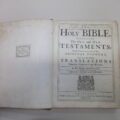Compiled by Trisha Bleau (Smith)
 Taken from Nelson’s Bible Dictionary:
Taken from Nelson’s Bible Dictionary:
The word “canon” means a “rod” — specifically, a rod with graduated marks used fro measuring length. This word refers to the list of individual books that were evenaully judged as authoritative and included in the Old Testament and the New Testament.
The early formation of the canon of the Old Testament is not easy to trace. Its threefold division in its early history – the Law, the Prophets, and the Writings — may reflect the three stages of its formation. From the beginning, the Law was accepted, even if it was not always obeyed. Evidence of its acceptance would include Moses’ reading of “the Book of the Covenant” to the people at Mount Sinai and the people’s response, “All that the Lord has said we will do, and be obedient” (Ex.24:7).
Further evidence of acceptance of the Law includes the discovery of the “Book of the Law,” probably the Book of Deuteronomy, in the Temple of Jerusalem during King Josiah’s reign and the religious reform that followed the discovery (2 Kin. 22:8-23;25) …………… (Edited section – removed by Trisha to shorten the overall compilation) ………. The prophets’ words were preserved from the beginning by their disciples, or by others who recognized the prophets as messengers of God. In general, their words were probably written shortly after they were spoken, for their authority as God’s messengers came before their wide spread acceptance by the Jewish people. The words of the prophets were not regarded as authoritative because they were included in the Old Testament; they were included because they were included because they were considered to be authoritative. …………Edited section again…………. The “Bible” Jesus used was the Hebrew Old Testament. He left no instructions about forming a new collection of authoritative writings to stand beside the books that He and His disciples accepted as God’s Word. The Old Testament was also the Bible of the early church, but it was the Old Testament as fulfilled by Jesus. Early Christians interpreted the Old Testament in the light of His person and work. This new perspective controlled the early church’s interpretation to such a degree that, while Jews and Christians shared the same Bible, they understood it so differently that they might almost have been using two different Bibles.
The works and words of Jesus were first communicated in spoken form. The apostles and their associates proclaimed the gospel by word of mouth. Paul taught the believers orally in the churches he founded when he was present. But when he was absent, he communicated through his letters. Quite early in its history, the church felt a need for a written account of the teachings of Jesus. His teachings did provide the basis for the new Christian way of life. But the church grew so large that many converts were unable to rely on the instructions of those who had heard and memorized the teachings of Jesus. From about A.D. 50 onward, probably more than one written collection of sayings of Jesus coriculated in the churches. The earliest written gospel appears to have been the Gospel of Mark, written about AD 64.
An individual gospel, a letter from an apostle, or even several works circulating indpendently, would not amount to a canon, or an authoritative list of books. A canon implies a collection of writings. There is evidence that two collections of Christian writings circulated among the churches at the beginning of the second century. One of these was the Gospel collection — the four writings commonly called the four gospels. The other collection was called the Pauline collection, or the letters of the apostle Paul. The anonymous letter to the Hebrews was added to this second collection at an early date.
 Early Christians continued to accept the Old Testament as authoritative. But they could interpret the Old Testament in the light of Jesus’ deeds and words only if they had a reliable record of them. So, alongside Moses and the prophets, they had these early writings about Jesus and letters from the apostles, who had know Jesus in the flesh. When officials of the early church sought to make a list of books about Jesus and the early church that they considered authoritative, they retained the Old Testament, on the authority of Jesus and His apostles. Along with these books they recognized as authoritative the writings of the new age — four gospels, or biographies on the life and ministry of Jesus; the 13 letters of Paul; and letters of other apostles and their companions. The gospel collection and apostolic collection were joined together by the Book of Acts, which served as a sequel to the gospel story, as well as a narrative background for the earlier epistles. The whole was concluded by
Early Christians continued to accept the Old Testament as authoritative. But they could interpret the Old Testament in the light of Jesus’ deeds and words only if they had a reliable record of them. So, alongside Moses and the prophets, they had these early writings about Jesus and letters from the apostles, who had know Jesus in the flesh. When officials of the early church sought to make a list of books about Jesus and the early church that they considered authoritative, they retained the Old Testament, on the authority of Jesus and His apostles. Along with these books they recognized as authoritative the writings of the new age — four gospels, or biographies on the life and ministry of Jesus; the 13 letters of Paul; and letters of other apostles and their companions. The gospel collection and apostolic collection were joined together by the Book of Acts, which served as a sequel to the gospel story, as well as a narrative background for the earlier epistles. The whole was concluded by
the Book of Revelation.
The primary standard applied to a book was that it must be written either by an apostle or by someone close to the apostles. This guaranteed that their writing about Jesus and the early church would have the authenticity of an eyewitness account. As in the earliest phase of the church’s existence, “the apostles’ doctrine” (Acts 2:42) was the basis of its life and thought. The apostolic writings formed the charter, or foundation documents, of the church.
None of the books written after the death of the apostles were included in the New Testament, although early church officials recognized they did have some value as inspirational documents. The fact that they were written later ruled them out for consideration amoung the church’s foundation documents. These other writings might be suitable for reading aloud in chruch because of their edigying character, but only the apostolic writings carried ultimate authority. They alone could be used as the basis of the church’s belief and practice.
Behind the BIble is the thrilling story of how God revealed Himself and His will to human spokesmaen and then acted throughout history to preserve His Word and pass it along to future generations. In the words of the prophet Isaiah, “The grass withers, the flower fades, but the Word of our God stands forever” (Is. 40:8).
Taken from The Best of Josh McDowell A Ready Defense by Bill Wilson
The word canon comes from the root word reed (English word cane; Hebrew form ganeh and Greek Kanon). The reed was used as a measuring rod and eventually meant “standard.” Origen used the word “canon to denote what we call the ‘rule of faith,’ the standard by which we are to measure and evaluate.” Later it meant a “list” or “index.” The word canon applied to Scripture means “an officially accpeted list of books.”
One thing to keep in mind is that the church did not create the canon or books included in what we call Scripture. Instead, the church recognized the books that were inspired from their inception. They were inspired by God when written.
Taken from When Skeptics Ask by Norman Geisler and Ron Brooks
HOW WAS THE BIBLE PUT TOGETHER?
How do we know that the sixty six books of the Bible are the only writings that should be included in Scripture? What about the Apocrypha, or the Gnostic gospels? Why shouldn’t they be included? The answer lies in the idea of canonicity. Canon comes from Greek and Hebrew words that mean a measuring rod, and it signifies a standard that all scriptural books must meet. Several inadequate views of what that standard should be have been offered, such as age, agreement with the Torah if it was written in Hebrew, religious value, and Christian usage. But each of these makes a common mistake; they confuse God’s determination of what is Scripture with man’s recognition of those writings. The bottom line is that watever God inspired is Scripture and what He did not inspire is not. When the Holy Spirit moved a man of God to write, that writing became, not only inspired, but inscripturated. God has already decided what should be included; our problem is knowing how to discover what writings God has inspired.
There are five questions that have been asked by the church in accepting and rejecting books as canonical. The first is the most basic:
1. Was it written by a prophet of God?
Deuteronomy 18:18 tells us that only a prophet of God will speak the Word of God. This is the way that God reveals Himself (Heb. 1:1). Second Peter 1:20-21 assures us that Scripture is only written by men of God.
2. Was he confirmed by an act of God?
Hebrews 2:3-4 gives us the idea that we should expect some miraculous confirmation of those who speak for God. Moses has his rod that turned into a serpent, Jesus had the Resurrection, and the apostles continued Jesus’ miracles, all to confirm that their message was from God. Many of the prophets had prophesies fulfilled shortly after they were made to confirm their authority.
3. Does it tell the truth about God?
“But even though we, or an angel from heaven, should preach to you a gospel contrary to that which we have preached to you, let him be accursed.” (Gal. 1:8) Agreement with all earlier revelation is essential. This dictum also rules out false prophecies made in the name of God (Deut. 18:22).
4. Does it have the power of God?
Any writing that does not exhibit the transforming power of God in the lives of its readers is not from God, “For the Word of God is living and active and sharper than any two-edged sword” (Heb. 4:12).
5. Was it accepted by the people of God?
Paul thanked the Thessalonians for receiving the apostles’ message as the Word of God (1 Thes. 2:13). It is the norm that God’s people, that is, the majority of them and not simply a faction, will initially recieve God’s Word as such. Moses’ scrolls were placed immediately into the ark of the covenant (Deut. 31:24-26) and Joshua’s writings were added in the same fashion (Josh. 24:26), as were Samuel’s (1 Sam. 10:25). Jeremiah is known as the plagiarizing prophet because he quoted so many of the other prophets who had written only a few years before him, which shows that their writings had been readily accepted. Daniel is seen studying the Book of Jeremiah within fifty years after it was written (Dan. 9:2). The New Testament also shows similar acceptance in that Peter calls Paul’s writings Scripture (2 Peter 3:16) and Paul quotes Luke alongside a passage from the Law (1 Tim. 5:18). We also are aware that Paul’s letters were circulated among the churches (Col. 4:16; 1 Thes. 5:27). This may have been the beginning of the collection of books for the New Testament canon. Though some books were later disputed, their original acceptance speaks strongly in favor of their inclusion.
Books that were questioned
- Hebrews — Because the author is unknown. Accepted as having apostolic authority, if not apostolic authorship.
- James — Because of the conflict with Paul’s teachings about salvation by faith alone. Conflict resolved by seeing works as an outgrowth of real faith.
- 2 Peter — Because the style differs from 1 Peter. But Peter used a scribe to write 1 Peter (see 5:12), who may have helped him to smooth out his Greek.
- 2 and 3 John — Because author is called “elder” and not apostle. However, Peter called himself an elder too (1 Pet. 5:1). They are cited in the earliest lists of canon.
- Jude — Because he refers to the Book of Enoch and the Assumption of Moses.
He does not call them Scripture, though, much like Paul quoting pagan poets (Acts 17:28; Titus 1:12). It had wide early acceptance. - Revelation — Because it teaches a thousand year reign of Christ, which was
taught by a certain cult. It was accepted by the earliest church fathers, though.





Be the first to comment